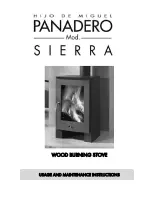
15
NOTE: When removing the upper baffles do not remove the screws;
just loosen them enough to allow the baffles to be removed.
Periodically, you must vacuum ashes from this chamber. In some
cases you will need to remove creosote, which can accumulate
rapidly under certain conditions. A small wire brush can be used. It is
important to remove this creosote because it is highly combustible.
INSPECT BEHIND THESE CLEANING PLATES AT LEAST ONCE PER
TON OF PELLETS BURNED UNTIL YOU ARE FAMILIAR WITH HOW
ASHES AND CREOSOTE ACCUMULATE WITH YOUR OPERATING
PRACTICES. Use the small wire brush to also clean the inside of the
chamber walls, above the access doors.
BLOWERS
DANGER: RISK OF ELECTRIC SHOCK. DISCONNECT POWER
BEFORE SERVICING UNIT.
Over a period of time, ashes or dust may collect on the blades of
both the combustion blower and convection blower. Periodically
the blowers should be vacuumed clean as these ashes can impede
performance. Creosote can also accumulate in the combustion
blower. This needs to be brushed clean. The convection blower is
accessed by removing the stove’s left side panel. The combustion
blower can be accessed by removing the stove’s right side panel. The
convection blower is on the left (facing stove), and the combustion
blower is on the right.
NOTE: When cleaning, be careful not to dislodge balancing clip on
convection blower or to bend fan blades. Some stove owners lightly
spray an anti-creosote chemical on the fire to help reduce creosote
formation within the stove.
CHIMNEY CLEANING
a. Creosote Formation – When any wood is burned slowly, it
produces tar and other organic vapors, which combine with
expelled moisture to form creosote. The creosote vapors
condense in the relatively cool chimney flue or a newly started
fire or from a slow-burning fire. As a result, creosote residue
accumulates on the flue lining. When ignited, this creosote
makes an extremely hot fire, which may damage the chimney
or even destroy the house. Despite their high efficiency, pellet
stoves can accumulate creosote under certain conditions.
b. Soot and Fly Ash: Formation and Need for Removal - The
products of combustion will contain small particles of fly
ash. The fly ash will collect in the exhaust venting system and
restrict the flow of the flue gases. Incomplete combustion, such
as occurs during startup, shutdown, or incorrect operation of
the room heater will lead to some soot formation which will
collect in the exhaust venting system. The exhaust venting
system should be inspected at least once every year or ton of
pellets burned to determine if cleaning is necessary.
c. Inspection and Removal – The chimney connector and chimney
should be inspected annually or per ton to determine if a
creosote or fly ash build-up has occurred. If creosote has
accumulated, it should be removed to reduce the risk of a
chimney fire. Inspect the system at the stove connection and
at the chimney top. Cooler surfaces tend to build creosote
deposits quicker, so it is important to check the chimney from
the top as well as from the bottom.
The creosote should be removed with a brush specifically designed
for the type of chimney in use. A qualified chimney sweep can
perform this service. It is also recommended that before each
heating season the entire system be professionally inspected,
cleaned and, if necessary, repaired. To clean the chimney, detach
the vent at the combustion blower transition where it is attached to
the blower.
RECOMMENDED MAINTENANCE SCHEDULE
Establish a routine for the fuel, wood burner and firing technique.
Check daily for creosote buildup until experience shows how often
you need to clean to be safe. Be aware that the hotter the fire the
less creosote is deposited, and weekly cleaning may be necessary
in mild weather even though monthly cleaning may be enough in
the coldest months. Contact your local municipal or provincial fire
authority for information on how to handle a chimney fire. Have a
clearly understood plan to handle a chimney fire. Use this as a guide
under average-use conditions.
Gasket around door and door glass should be inspected and repaired
or replaced when necessary (see “Replacement Parts” section of
this manual). This unit’s door uses a 3/4” (20 mm) diameter rope
gasket.
REMOVAL AND REPLACEMENT OF BROKEN DOOR GLASS
While wearing leather gloves (or any other gloves suitable for
handling broken glass), carefully remove any loose pieces of glass
from the door frame. Dispose of all broken glass properly. Return
the damaged door to your dealer for repair or replacement. Neither
the appliance owner nor any other unauthorized person(s) should
replace the door glass. An authorized dealer must perform all
repairs involving door glass.
CAUTION: This wood heater needs periodic inspection and
repair for proper operation. It is against federal regulations
to operate this wood heater in a manner inconsistent with
operating instructions in this manual.
Daily
Weekly
Annually or
per Ton
Burn Pot
Stirred Emptied
Glass
Wiped
Cleaned
Combustion Chamber
Brushed
Ashes
Emptied
Interior Chambers
Vacuumed
Heat Exchange Tubes
Two
passes
Combustion Blower Blades
Vacuumed /
Brushed
Convection Blower Impeller
Vacuumed /
Brushed
Vent System
Cleaned
Gaskets
Inspected
Hopper (end of season)
Emptied and
vacuumed
















































